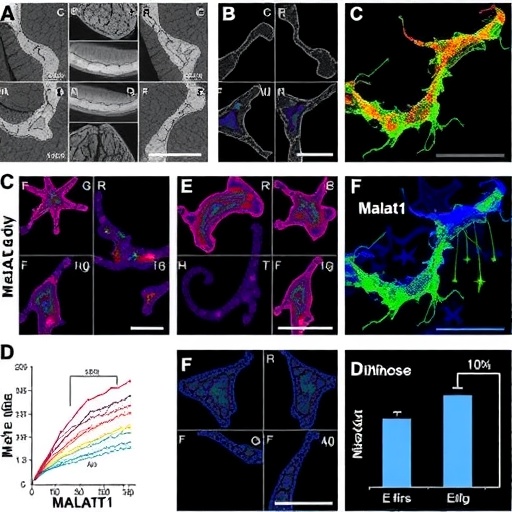In a groundbreaking study that delves into the intricate relationship between long non-coding RNAs (lncRNAs) and neuroprotection, researchers from China have elucidated the role of MALAT1 (MALAT1) in protecting mouse hippocampal neurons under hyperglycemic conditions. The findings, published in the journal BMC Endocrine Disorders, reveal significant insights that may pave the way for novel therapeutic strategies in the treatment of diabetes-associated cognitive dysfunctions.
The study focuses on the prominent cellular stressor: high glucose levels. Chronic hyperglycemia is not only a hallmark of diabetes but also a significant risk factor for neurodegenerative diseases. Understanding how elevated glucose causes neuronal death is critical for countering the progression of these disorders. At its core, this research unravels how the MALAT1 lncRNA contributes to neuronal survival in the face of such stress.
Recent findings indicate that extended exposure to high glucose can trigger apoptosis, a well-known programmed cell death mechanism. This phenomenon is particularly concerning for neurons, which have limited regenerative capabilities. By investigating the protective mechanisms involved, the researchers sought to determine whether specific genetic factors could modulate neuronal responses to oxidative and metabolic stresses.
.adsslot_AIr0kf9oV7{ width:728px !important; height:90px !important; }
@media (max-width:1199px) { .adsslot_AIr0kf9oV7{ width:468px !important; height:60px !important; } }
@media (max-width:767px) { .adsslot_AIr0kf9oV7{ width:320px !important; height:50px !important; } }
ADVERTISEMENT
One of the key elements under investigation was the role of autophagy, a cellular process responsible for degrading and recycling cellular components. Dysfunctional autophagy has been implicated in various neurodegenerative conditions, including Alzheimer’s disease and Parkinson’s disease. The researchers hypothesized that by silencing MALAT1, a robust protective response involving autophagy might be hindered in mouse hippocampal neurons.
The methodology adopted in this research is commendable, as it utilizes advanced molecular techniques to achieve precise genetic modifications. By leveraging CRISPR/Cas9 technology, the research team successfully knocked down MALAT1 expression in cultured mouse hippocampal neuronal cells. This genetic modulation was pivotal in illuminating the protective pathways activated during hyperglycemic stress.
Moreover, the research provided compelling evidence of the interplay between MALAT1 and autophagy. The study showed that the decrease in MALAT1 expression corresponded with reduced autophagy markers, further highlighting its role in sustaining neuronal health under stress. This intricate relationship illustrates how lncRNAs serve as vital regulators of cellular pathways that define neuronal fate amid pathological insults.
The implications of this research extend beyond the realm of basic science. By establishing MALAT1 as a neuroprotective agent, the findings pave the way for potential clinical applications. For instance, if MALAT1 can be upregulated in patients with diabetic-related cognitive dysfunction, it could represent a promising therapeutic target. The notion of enhancing neuroprotection through modulation of lncRNA levels offers an exciting avenue for further research.
The challenges posed by diabetes are multifaceted, affecting millions worldwide. As researchers continue to unravel the genetic and molecular underpinnings of this disease, studies like this signify key advancements in our understanding of the neurobiological consequences of diabetes. The revelation that MALAT1 can potentially shield neurons from high glucose-induced apoptosis offers hope for developing innovative therapies aimed at preserving cognitive function.
Furthermore, the findings underscore the importance of exploring lncRNAs in a clinical context. While traditionally overlooked in favor of protein-coding genes, lncRNAs have emerged as crucial modulators of gene expression and cellular behavior. Their versatility and ability to interact with various molecular targets make them integral to the intricate web of cellular signaling pathways.
As the research community shifts its focus towards more inclusive models of gene regulation, the implications of findings such as these cannot be understated. They highlight the necessity for a multidimensional approach that encompasses both coding and non-coding elements of the genome. The unfolding story of lncRNAs like MALAT1 represents a paradigm shift that could redefine our understanding of gene therapy and neuroprotection.
In conclusion, Zhang et al.’s study provides a compelling case for the role of MALAT1 in neuroprotection against high glucose-induced apoptosis. The research opens up significant avenues for clinical interventions and underscores the importance of lncRNAs in neuronal health. As the quest to understand neurodegenerative diseases continues, studies like this pave the way for innovative therapies that could ultimately enhance the quality of life for individuals suffering from diabetes-related neurological complications.
The ongoing exploration within this field promises to uncover additional lncRNAs and their respective roles in cellular resilience. The hope is that future investigations will further elucidate the mechanisms by which these non-coding RNAs contribute to neuronal survival, potentially leading to groundbreaking advancements in neuroprotective therapies. As the science progresses, one thing is certain: the lncRNA landscape is ripe with opportunities waiting to be discovered.
Strong prospects lie ahead for the application of this knowledge in clinical scenarios, particularly facing the growing epidemic of diabetes. By integrating findings from fundamental research into clinical practice, there is potential to redefine how we approach the management of diabetic complications, especially those affecting cognitive health. With continued efforts in this domain, the ambitious aim of mitigating cognitive decline in diabetic patients may become a reality.
The intricate world of gene regulation is only beginning to be understood, and studies such as this provide invaluable insights. By focusing on the connections between lncRNAs and other cellular processes, researchers are crafting a more comprehensive understanding of cellular responses to stress. The future of neurobiology is undoubtedly intertwined with the growing appreciation for the role of long non-coding RNAs in health and disease.
Subject of Research: The role of lncRNA MALAT1 in inhibiting apoptosis of mouse hippocampal neurons under high glucose conditions.
Article Title: LncRNA MALAT1 knockdown inhibits apoptosis of mouse hippocampus neuron cells with high glucose by Silencing autophagy.
Article References:
Zhang, X., Shi, Y., Wang, C. et al. LncRNA MALAT1 knockdown inhibits apoptosis of mouse hippocampus neuron cells with high glucose by Silencing autophagy. BMC Endocr Disord 25, 173 (2025). https://doi.org/10.1186/s12902-025-01990-5
Image Credits: AI Generated
DOI:
Keywords: lncRNA, MALAT1, apoptosis, hippocampal neurons, high glucose, autophagy, neuroprotection, diabetes, neurodegenerative diseases.
Tags: apoptosis in hippocampal neuronsautophagy and neuronal healthcellular stress response mechanismschronic hyperglycemia and neurodegenerationdiabetes-related neuroprotective researchgenetic factors and neuronal survivalhigh glucose neuronal apoptosislong non-coding RNAs in neurobiologyMALAT1 knockdown effectsneuroprotection in diabetesoxidative stress in diabetestherapeutic strategies for cognitive dysfunction





